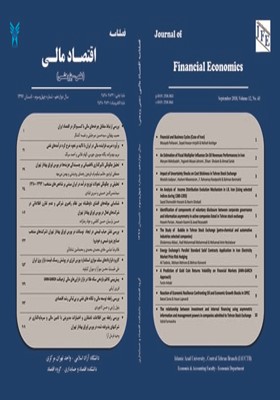بررسی رابطه بین اطلاعات نامتقارن و اختیارات مدیریتی با تامین مالی و سرمایهگذاری در شرکتهای پذیرفته شده در بورس اوراق بهادار تهران
محورهای موضوعی : اقتصاد مالی
1 - دکتری اقتصاد و مدرس دانشگاه، کارشناس ارشد بازار سرمایه، تهران، ایران.
کلید واژه: اطلاعات نامتقارن, G14, واژههای کلیدی: سرمایهگذاری, اختیارات مدیریتی, جریان نقد. طبقه بندی JEL : E22,
چکیده مقاله :
با توجه به تحولات صورت گرفته در دنیای اقتصاد و حضور در فضای رقابتی، شرکتها ناگزیر از استفاده از روش های مناسب در جهت استفاده از امکانات و منابع خود می باشند. یکی از مباحث مورد توجه در این زمینه سرمایه گذاری است. با توجه به محدودیت منابع، علاوه بر مسئله توسعه سرمایه گذاری، کارایی سرمایه گذاری نیز از مسائل بسیار با اهمیت به شمار می رود. در تحقیق حاضر تلاش شده است که رابطه ی میان میزان سرمایه گذاری و تأمین مالی داخلی با استفاده از اطلاعات نامتقارن و اختیارات مدیریتی با استفاده از داده های مربوط به شرکت های پذیرفته شده در بورس اوراق بهادار تهران که در دوره ی زمانی سال 1391 تا 1395عرضه اولیه آنها انجام شده، سنجیده شود. بررسی فرضیه های تحقیق به کمک آزمون همبستگی پیرسون و تحلیل رگرسیونی در دوره مورد نظر گواه بر رابطه مثبت میان این متغیر سرمایه گذاری و جریان نقدی عملیاتی به صورت کلی است. رابطه مثبت میان سرمایه گذاری و اختیارات مدیریتی نیز تأیید شد، در حالیکه رابطه بدست آمده بین سرمایه گذاری و اطلاعات نامتقارن منفی برآورد شده است. Given the developments in the world of economics and the presence of a competitive environment, companies are forced to use appropriate methods to use their resources. One of the topics discussed in this field is investment. Due to resource constraints, in addition to investment development, investment efficiency is also a very important issue. In the present study, the relationship between the amount of investment and internal financing using asymmetric information and management powers by using the data of companies accepted in the Tehran Stock Exchange in the period of 1391 By 1395 their initial launch has been made. Investigating the hypothesis of the research with the help of Pearson correlation test and regression analysis in the period under review, is a positive relationship between this investment variable and operating cash flow in general. The positive relationship between investment and management powers was also confirmed, while the relationship between investment and negative asymmetric information was estimated.

